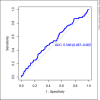Lack of Prognostic Value of Pretreatment Neutrophil-to-Lymphocyte Ratio in Early Breast Cancer
- PMID: 36590145
- PMCID: PMC9801394
- DOI: 10.1159/000525287
Lack of Prognostic Value of Pretreatment Neutrophil-to-Lymphocyte Ratio in Early Breast Cancer
Abstract
Background: Breast cancer is a highly heterogeneous disease with large differences in the risk of recurrence. An elevated neutrophil-to-lymphocyte ratio (NLR) is correlated with a poor prognosis in a variety of tumors, and although it is still controversial in breast cancer, there are multiple studies, including meta-analysis, suggesting this. The purpose of this study was to analyze the prognostic value of preoperative NLR in an Argentine population of patients with nonmetastatic breast cancer, not exposed to neoadjuvant treatment.
Methods: Retrospective multicenter cohort study that includes patients over 18 years of age from three centers in the city and province of Buenos Aires who have had surgery for early breast cancer between January 1, 1999, and December 31, 2014. Based on the previous literature, a cutoff value of 2.0 was defined.
Results: A total of 791 patients were eligible for the analysis. Median age was 55 years (IQR 45-65). Median NLR was 1.92 (IQR 1.50-2.56). The distribution of groups according to the 8th edition of the AJCC was 54.1% for stage I, 35.6% stage II, and 10.4% stage III. Among the different tumor phenotypes, 79.0% were HR+/HER2-, 11.4% were HR+ or-/HER2+, and 9.2% were HR-/HER2-. With a median follow-up of 5.3 years, 112 patients (14.2%) had disease recurrence. Stage III patients had a higher NLR than stage I and stage II patients (p = 0.002). The rest of the clinical and pathological characteristics did not show differences in the groups according to NLR. There were no differences in relapse-free survival according to the NLR (p = 0.37), and it did not change after adjusting for other prognostic variables.
Conclusion: We consider it is important to determine the efficacy of prognostic markers that are easily accessible and of simple, systematic application. However, NLR does not appear to be an independent prognostic factor for recurrence in our population. In this sense, we consider it is important to publish negative results in order to avoid publication bias.
Keywords: Early breast cancer; Neutrophil-to-lymphocyte ratio; Prognostic factor.
Copyright © 2022 by S. Karger AG, Basel.
Conflict of interest statement
The authors declare that they have no competing interests.
Figures




References
-
- Ferlay J, Soerjomataram I, Dikshit R, Eser S, Mathers C, Rebelo M, et al. Cancer incidence and mortality worldwide: sources, methods and major patterns in GLOBOCAN 2012. Int J Cancer. 2015;136:E359–86. - PubMed
-
- Voduc KD, Cheang MCU, Tyldesley S, Gelmon K, Nielsen TO, Kennecke H. Breast cancer subtypes and the risk of local and regional relapse. J Clin Oncol. 2010;28:1684–91. - PubMed
LinkOut - more resources
Full Text Sources
Research Materials
Miscellaneous

